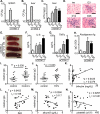Innate lymphoid cells promote anatomical containment of lymphoid-resident commensal bacteria
- PMID: 22674331
- PMCID: PMC3659421
- DOI: 10.1126/science.1222551
Innate lymphoid cells promote anatomical containment of lymphoid-resident commensal bacteria
Abstract
The mammalian intestinal tract is colonized by trillions of beneficial commensal bacteria that are anatomically restricted to specific niches. However, the mechanisms that regulate anatomical containment remain unclear. Here, we show that interleukin-22 (IL-22)-producing innate lymphoid cells (ILCs) are present in intestinal tissues of healthy mammals. Depletion of ILCs resulted in peripheral dissemination of commensal bacteria and systemic inflammation, which was prevented by administration of IL-22. Disseminating bacteria were identified as Alcaligenes species originating from host lymphoid tissues. Alcaligenes was sufficient to promote systemic inflammation after ILC depletion in mice, and Alcaligenes-specific systemic immune responses were associated with Crohn's disease and progressive hepatitis C virus infection in patients. Collectively, these data indicate that ILCs regulate selective containment of lymphoid-resident bacteria to prevent systemic inflammation associated with chronic diseases.
Figures




Comment in
-
Mucosal immunology: IL-22 keeps commensals in their place.Nat Rev Immunol. 2012 Jul 6;12(8):550-1. doi: 10.1038/nri3263. Nat Rev Immunol. 2012. PMID: 22767156 No abstract available.
References
-
- Hooper LV, Macpherson AJ. Immune adaptations that maintain homeostasis with the intestinal microbiota. Nat Rev Immunol. 2010 Mar;10:159. - PubMed
-
- Ley RE, Peterson DA, Gordon JI. Ecological and evolutionary forces shaping microbial diversity in the human intestine. Cell. 2006 Feb 24;124:837. - PubMed
-
- Macpherson AJ, Uhr T. Induction of protective IgA by intestinal dendritic cells carrying commensal bacteria. Science. 2004 Mar 12;303:1662. - PubMed
Publication types
MeSH terms
Substances
Grants and funding
- R01 AI074878/AI/NIAID NIH HHS/United States
- AI061570/AI/NIAID NIH HHS/United States
- T32-AI055428/AI/NIAID NIH HHS/United States
- AI47619/AI/NIAID NIH HHS/United States
- T32 RR007063/RR/NCRR NIH HHS/United States
- AI087990/AI/NIAID NIH HHS/United States
- P30DK50306/DK/NIDDK NIH HHS/United States
- 2-P30 CA016520/CA/NCI NIH HHS/United States
- K08 DK093784/DK/NIDDK NIH HHS/United States
- R21 AI083480/AI/NIAID NIH HHS/United States
- U01 AI095608/AI/NIAID NIH HHS/United States
- R01 AI061570/AI/NIAID NIH HHS/United States
- AI095466/AI/NIAID NIH HHS/United States
- P30 AI 045008/AI/NIAID NIH HHS/United States
- T32 AI055428/AI/NIAID NIH HHS/United States
- R01 AI095466/AI/NIAID NIH HHS/United States
- P30 DK050306/DK/NIDDK NIH HHS/United States
- T32 AI007532/AI/NIAID NIH HHS/United States
- K08-DK093784/DK/NIDDK NIH HHS/United States
- P30 AI045008/AI/NIAID NIH HHS/United States
- AI074878/AI/NIAID NIH HHS/United States
- T32-AI007532/AI/NIAID NIH HHS/United States
- AI083480/AI/NIAID NIH HHS/United States
- R01 AI102942/AI/NIAID NIH HHS/United States
- T32-RR007063/RR/NCRR NIH HHS/United States
- R21 AI087990/AI/NIAID NIH HHS/United States
- AI095608/AI/NIAID NIH HHS/United States
- P30 CA016520/CA/NCI NIH HHS/United States
LinkOut - more resources
Full Text Sources
Other Literature Sources

